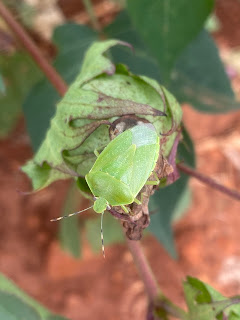Cotton
Most of the reports we have received this week is that
overall, we are in pretty good shape. However. There are some fields that are in
need of reprieve. We have some fields in SW Alabama that cannot miss a rain,
and other fields in N Alabama that cannot catch a rain. Cotton across much of
central Alabama looks to be in good shape. We are hopeful for a good August and
September so we can finish the crop out and maximize whatever yield potential
we have in the field as of today.
Bug Complex
Not much has changed with the bug complex (plant bugs +
stink bugs) situation over the past 7 days. Some fields are still requiring attention
from plant bugs, but we are at the point with most of our cotton that we need
to kill stink bugs when going across the field. We walked some fields today in S Alabama with a 2x threshold of both plant bugs and stink bugs. Many of these fields were missing lots of fruiting sites, but still have time to make a top crop if bugs are managed moving forward.
Our observations and reports have been that most fields
sprayed over the past week to 10 days have not required follow up sprays. We
typically expect to get about 2 weeks out of a stink bug spray before
retreatment is necessary. This is not residual control, just typically about
the time it takes another infestation of stink bugs to build to population
levels that can cause economic damage (=10% internal damage). This may not be
the case if sources of stink bug populations are nearby (corn, peanuts, pecans,
etc.) and fields should still be monitored weekly to ensure damage is not building.
Spider Mites
We have received reports that spider mites are requiring
attention, primarily in the Wiregrass this week. Abamectin is typically the
go-to for mites based on economics, but we wouldn’t normally recommend using
abamectin as a follow up if retreatment is needed. There are pockets of
resistance across the southern Cotton Belt and if abamectin doesn’t provide satisfactory
control one week, I would not expect much to change the following week. We
talked about alternative options in last week’s Blog (link).

Bollworm in cotton.

Bollworms
Thus far, the bollworm flight has seemed to be pretty low
overall when looking at our trap counts across the state. Historically, the
expected peak flight varies with South Alabama ≈July 10, Central AL ≈July
20 and North AL ≈August 1. However, we have received reports of egg lays
varying from 1-10% in the TN Valley and high numbers of moths in fields in SE
Alabama. In general, we do not recommend making insecticide applications based
on eggs in Alabama, as we still rarely find escaped worms in our Bt cottons.
Peanuts
We are beginning to hear about infestations of defoliating
caterpillars in peanut fields. Often, we have a complex of species including green
cloverworms, soybean loopers, velvetbean caterpillars and some others such as
fall armyworms, beet armyworms, bollworms, cutworms, or others. Our threshold
is 4-8 worms per foot of row. The low end is advised when peanuts are small or
stressed from other factors.
We also have received reports of lesser cornstalk borers
(LCB) requiring treatment in the Wiregrass. This pest prefers fields with skippy
stands and they thrive in hot, dry conditions. With the loss of chlorpyrifos (Lorsban),
we only have a couple of options including chlorantraniliprole (Vantacor
1.2-2.5 oz), or chlorantraniliprole products pre-mixed with the pyrethroids
bifenthrin (Elevest 5.6-9.6 oz) or lambda-cyhalothrin (Besiege 10 oz). Another option is the insect growth regulator Diamond (6-12 oz). Keep in mind that the
weather conditions that LCB thrive in are the same the spider mites can blow up
in as well. If spider mites are a concern, consider using products without the
added pyrethroid as this may flare mites.
Deer Survey
In response to a farmer request, the Alabama Extension
Agronomics Crops Team is conducting a survey to better understand the impacts
of deer population on crop production. Please take a few moments to help us
collect information to try to use to figure out ways to mitigate deer losses in
your row crops.
You can take the anonymous survey here (link).
Take Home Points
If you would like to provide reports or observations on the insect situation from your region, please let us know. You can reach Scott Graham at 662-809-3368 or scottg@auburn.edu or Ron Smith at 334-332-9501 or smithrh@auburn.edu.
As always, if we can ever be of any help, please let us know.














